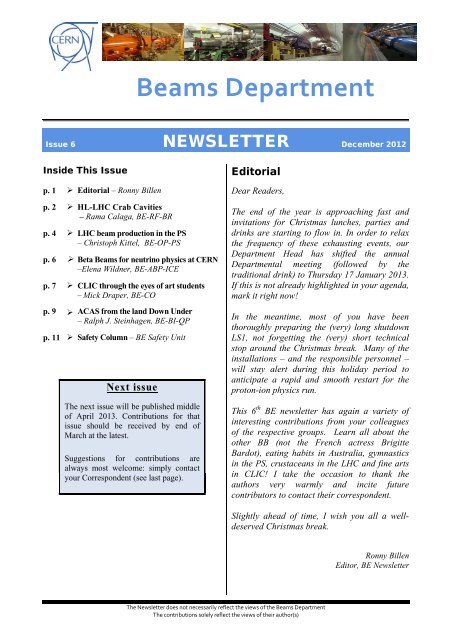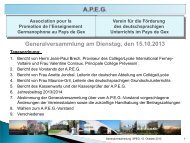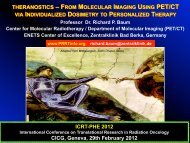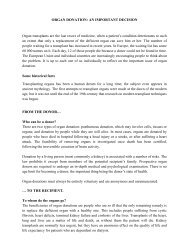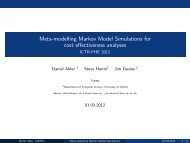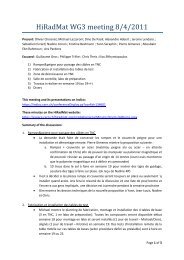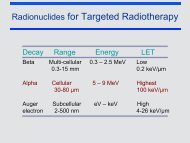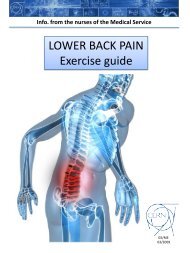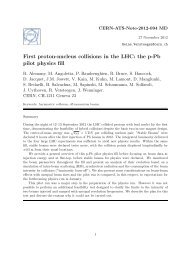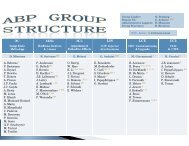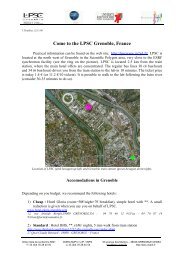Newsletter - Cern
Newsletter - Cern
Newsletter - Cern
You also want an ePaper? Increase the reach of your titles
YUMPU automatically turns print PDFs into web optimized ePapers that Google loves.
Beams Department<br />
Issue 6 NEWSLETTER December 2012<br />
Inside This Issue<br />
p. 1 � Editorial – Ronny Billen<br />
p. 2 � HL-LHC Crab Cavities<br />
– Rama Calaga, BE-RF-BR<br />
p. 4 � LHC beam production in the PS<br />
– Christoph Kittel, BE-OP-PS<br />
p. 6 � Beta Beams for neutrino physics at CERN<br />
–Elena Wildner, BE-ABP-ICE<br />
p. 7 � CLIC through the eyes of art students<br />
– Mick Draper, BE-CO<br />
p. 9 � ACAS from the land Down Under<br />
– Ralph J. Steinhagen, BE-BI-QP<br />
p. 11 � Safety Column – BE Safety Unit<br />
Next issue<br />
The next issue will be published middle<br />
of April 2013. Contributions for that<br />
issue should be received by end of<br />
March at the latest.<br />
Suggestions for contributions are<br />
always most welcome: simply contact<br />
your Correspondent (see last page).<br />
Editorial<br />
Dear Readers,<br />
The end of the year is approaching fast and<br />
invitations for Christmas lunches, parties and<br />
drinks are starting to flow in. In order to relax<br />
the frequency of these exhausting events, our<br />
Department Head has shifted the annual<br />
Departmental meeting (followed by the<br />
traditional drink) to Thursday 17 January 2013.<br />
If this is not already highlighted in your agenda,<br />
mark it right now!<br />
In the meantime, most of you have been<br />
thoroughly preparing the (very) long shutdown<br />
LS1, not forgetting the (very) short technical<br />
stop around the Christmas break. Many of the<br />
installations – and the responsible personnel –<br />
will stay alert during this holiday period to<br />
anticipate a rapid and smooth restart for the<br />
proton-ion physics run.<br />
This 6 th BE newsletter has again a variety of<br />
interesting contributions from your colleagues<br />
of the respective groups. Learn all about the<br />
other BB (not the French actress Brigitte<br />
Bardot), eating habits in Australia, gymnastics<br />
in the PS, crustaceans in the LHC and fine arts<br />
in CLIC! I take the occasion to thank the<br />
authors very warmly and incite future<br />
contributors to contact their correspondent.<br />
Slightly ahead of time, I wish you all a welldeserved<br />
Christmas break.<br />
The <strong>Newsletter</strong> does not necessarily reflect the views of the Beams Department<br />
The contributions solely reflect the views of their author(s)<br />
Ronny Billen<br />
Editor, BE <strong>Newsletter</strong>
HL-LHC Crab Cavities<br />
The HL-LHC upgrade aims at reducing the beam<br />
sizes at the interaction points of ATLAS and CMS<br />
by approximately a factor of 2 to enhance the<br />
luminosity reach beyond the nominal LHC. Due to<br />
the common focusing channel in the interaction<br />
regions and small bunch spacing (25 ns), the two<br />
beams have to be separated transversely,<br />
horizontally or vertically to avoid parasitic collisions<br />
in the neighboring bunches. This separation leads to<br />
a non-zero crossing angle at the interaction point<br />
which is inversely proportional to the transverse<br />
beam size at the interaction point. As a consequence,<br />
the overlap of the colliding bunches for smaller<br />
beam sizes, with larger crossing angle, is less<br />
effective as depicted in Fig. 1 below.<br />
The incomplete overlap due to the crossing angle<br />
results in a luminosity reduction when compared to<br />
the case where bunches collide head-on. For<br />
bunches with a Gaussian distribution, this is<br />
conveniently expressed by the well-known Piwinski<br />
reduction factor<br />
1
esult of this R&D during the past 5 years, three<br />
compact designs at 400 MHz have emerged as<br />
potential candidates. They are not only smaller in<br />
transverse size by approximately 4 times than their<br />
conventional counterpart, but also exhibit superior<br />
RF properties. As a first step of RF design<br />
validation, all three cavities are being prototyped to<br />
undergo comprehensive tests to determine the best<br />
candidate for the LHC upgrade. These new<br />
topologies make it possible to integrate the<br />
cryomodules in the present LHC interaction region<br />
and also allow for the alternating crossing scheme<br />
(horizontal and vertical at IR1 and IR5 respectively)<br />
which is a prerequisite.<br />
Two of the cavity designs (see below: the 4-rod and<br />
the double ridge) have been prototyped using bulk<br />
Niobium metal in industry. They are pending surface<br />
and heat treatment before cryogenic and gradient<br />
testing this fall in the SM18 test facility and in the<br />
U.S. respectively. The fabrication of the third<br />
quarter wave design also using bulk Niobium is<br />
underway and expected to undergo tests early 2013.<br />
The timeline for R&D is synchronized with the<br />
present LHC running schedule and the HL-LHC<br />
project. Three clear milestones are set to determine<br />
the final construction of the hardware to become<br />
available for the final installation in the LHC circa<br />
2022-23.<br />
1. A validation of the three different cavity designs<br />
up to the nominal field in a vertical test setup is<br />
to take place by the end of 2012 with further tests<br />
continuing into 2013 and possibly beyond.<br />
2. At the same time, infrastructure preparation is<br />
foreseen during the upcoming long shutdown<br />
LS1 and subsequent technical stops in order to be<br />
able to carry out important beam tests in the SPS.<br />
This is essential; KEKB successfully<br />
demonstrated crabbing with electrons – no such<br />
tests have ever been done in a proton accelerator<br />
and, additionally, we must be sure there are no<br />
potential risks for LHC beam operation. A Crab<br />
Cavity Technical Coordination working group at<br />
CERN (CCTC) will identify and resolve all<br />
aspects related to such a test in the SPS. It is also<br />
foreseen that the test setup from the SPS can be<br />
transported to IR4 of the LHC for specific beam<br />
tests deemed necessary before installation of the<br />
complete systems in the LHC.<br />
3. Beam tests in the SPS with a prototype<br />
cryomodule and followed by tests in the LHC<br />
IR4 are therefore pre-requisites for a final<br />
installation in points 1 and 5. These tests have to<br />
take place well before the LS2 shutdown.<br />
3 Beams Department <strong>Newsletter</strong> Issue 6
Upon successful beam tests in the SPS and<br />
potentially in the LHC, construction of the final 8<br />
cryomodules to be installed at IP1 and IP5 will be<br />
launched. This final crab system will be realized as a<br />
joint effort with CERN, EuCARD, USLARP and<br />
other worldwide partners involved. An LHC HiLumi<br />
Design Study proposal to the European Union within<br />
the FP7 framework Protocol concerning the initial<br />
phase of the HL-LHC project, including a work<br />
package in Crab Cavities, was well received and<br />
given approval in 2010.<br />
Cavity design and test is of course only part of the<br />
crab cavity project. Many other systems are needed<br />
both in the tests and in the final system. For<br />
example a high performance low noise RF power<br />
system and associated controls are needed to<br />
precisely regulate the cavity fields at timescales of<br />
100µs.<br />
There will be challenges in the domains of controls<br />
and instrumentation demanding expertise from the<br />
CO and BI groups of BE. The cryogenic system to<br />
operate the cavities at 2K will be primarily<br />
developed at CERN. Considerable support will be<br />
needed from Engineering and Technology teams in<br />
the Accelerator sector. In parallel to the technology<br />
development, a significant effort to understand the<br />
beam dynamics aspects, cavity failure scenarios and<br />
the long term stability of the LHC beams in the<br />
presence of crab crossing, involving BE teams from<br />
ABP and OP, has started and will continue<br />
throughout the project.<br />
Rama Calaga, BE-RF-BR<br />
LHC beam production in the PS<br />
The integrated luminosity with proton-proton<br />
collisions in LHC just exceeded 20 inverse<br />
femtobarns with, in turn, lots of interesting physics<br />
results. However, in order to be able to achieve<br />
record luminosities and record fills, the injectors<br />
must perform as well at peak efficiency, producing<br />
the correct beam properties with the best possible<br />
beam quality. Prior to injection into the LHC, the<br />
beam has to undergo extensive manipulations in the<br />
injector chain to meet the high expectations.<br />
After leaving the source the beam passes through<br />
four accelerators before finally entering into the<br />
LHC at energy of 450 GeV. Each proton has then<br />
travelled already several million kilometers, many<br />
times the distance between earth and moon.<br />
The Proton Synchrotron (PS), third stage in the<br />
cascade of the four injectors, accelerates the proton<br />
beam from 1.4 to 26 GeV. The LHC multi-bunch<br />
beam is one of the most evolved ones, produced in<br />
the PS. This can be seen already from its cycle<br />
length of three basic periods, corresponding to 3.6<br />
seconds, the longest in PS. The demands on key<br />
parameters such as transverse beam size and equality<br />
of bunch intensities are constantly pushing the limits<br />
of PS. This explains why already the injection from<br />
the PS Booster (PSB) is special, done in two steps in<br />
order to keep a smaller transversal beam size.<br />
With the first PSB cycle one bunch from each ring is<br />
injected into four out of seven radiofrequency (RF)buckets.<br />
After staying 1.2 seconds at injection<br />
energy, a second PSB cycle injects two more<br />
bunches into the subsequent two RF-buckets. One<br />
RF-bucket remains empty, leaving a gap of at least<br />
300 ns, sufficient time to allow later the ejection<br />
kicker rising to full strength before kicking the beam<br />
in one turn into the transfer line towards SPS.<br />
The main task for the PS, next to the acceleration of<br />
course, is to generate the final longitudinal bunch<br />
spacing for the LHC (see Fig. 1). This involves<br />
different RF-manipulations. In all of them the<br />
number of RF-buckets per turn, expressed by the<br />
harmonic number of the RF, is changed. The<br />
harmonic number is the ratio between the frequency<br />
in the RF-cavity and the revolution frequency of the<br />
particles around the accelerator.<br />
Fig. 1 Splitting scheme of LHC beam in PS<br />
To split bunches in two parts the harmonic is<br />
doubled. The redistribution of the particles from one<br />
4 Beams Department <strong>Newsletter</strong> Issue 6
into two RF-buckets is done by reducing the voltage<br />
of the cavity with the lower harmonic, while<br />
increasing at the same time the voltage of the<br />
cavities with the higher harmonic and a phase shift<br />
of 180 degrees (see Fig. 2a). Without the phase shift<br />
however it is merely a harmonic number change, a<br />
so-called rebucketing (see Fig. 2b). To split bunches<br />
in three parts in one step, three different RF<br />
harmonics, h = 7, 14 and 21 are applied<br />
simultaneously to the beam. The intermediate RF<br />
component at h = 14 assures a splitting into three<br />
equal bunches.<br />
Fig. 2 (a) Double splitting and (b) Rebucketing<br />
A mountain range plot of 2 nd injection and triple<br />
splitting, measured on the PS flat-bottom, is shown<br />
in Fig. 3. Having now 18 bunches in harmonic 21<br />
the beam is accelerated to 26 GeV, its final energy in<br />
PS. Each bunch is then split in two on the flat top,<br />
changing the harmonic from 21 to 42, a mountain<br />
range plot is shown in Fig. 4. Effectively each of the<br />
injected bunches is split by a factor of six. This<br />
result in a batch of 36 bunches spaced by 50 ns.<br />
Finally the bunches undergo a rebucketing from<br />
harmonic 42 to 84.<br />
Fig. 3 2 nd injection and triple splitting<br />
Fig. 4 Double splitting with subsequent rebucketing<br />
Just before extraction the 36 bunches are drastically<br />
shortened to a bunch length of about 4 ns in order to<br />
fit into the 5 ns long RF-buckets (200 MHz) in the<br />
SPS. This is achieved by a sudden increase of the<br />
RF-Voltage at harmonic 84, which introduces a<br />
longitudinal bunch rotation in the RF-bucket. To<br />
further increase the RF voltage gradient, additional<br />
cavities at harmonic 168 are switched on during the<br />
last part of this rotation. When the bunches are<br />
shortest, the batch is ejected into the transfer line<br />
towards SPS. Up to four of these batches can be<br />
accumulated in one SPS cycle prior to their<br />
acceleration and following transfer to the LHC.<br />
Another important task of the PS is preserving the<br />
beam quality delivered by the booster. The quality of<br />
the beam is expressed by its longitudinal and<br />
transverse emittances, important measures of<br />
particle density.<br />
A certain emittance increase (blow up) is difficult to<br />
avoid and sometimes even necessary in order to<br />
stabilize the beam. A longitudinal blow up can for<br />
example ease a splitting process, when done in a<br />
controlled way.<br />
The transverse emittance should however be<br />
conserved as well as possible throughout the injector<br />
chain. A possible source of blow up may be for<br />
example coherent transverse injection oscillations.<br />
The bunches are then oscillating transversally<br />
around the ideal orbit due to a not perfectly aligned<br />
beam trajectory at injection. Also non-perfect<br />
working point settings can produce resonances,<br />
especially with very bright beams like the LHC<br />
beams. Both cases finally lead to filamentation of<br />
the beam, translating into a transverse emittance<br />
increase.<br />
In order to detect subtle changes more quickly the<br />
LHC beam quality is validated during each shift in<br />
all the injectors.<br />
Christoph Kittel, BE-OP-PS<br />
5 Beams Department <strong>Newsletter</strong> Issue 6
Beta Beams for neutrino physics<br />
at CERN<br />
CERN has a long experience in developing and<br />
running neutrino beams. S. van der Meer invented<br />
the idea of the magnetic horn, successfully used in<br />
most neutrino beam facilities worldwide to optimize<br />
the neutrino flux towards the detector. The “CERN<br />
Neutrinos to Gran Sasso” (CNGS) facility has been<br />
running since 2006. New proposals are emerging to<br />
pursue the exploration of the neutrino at CERN. The<br />
result of the 4-year FP7 study “EUROnu”<br />
(http://euronu.org) of three neutrino facilities, a<br />
Neutrino Factory, a Beta Beam and a so-called<br />
Super Beam, is now being published in the EUROnu<br />
final report and in an upcoming special issue of the<br />
journal PRSTAB. The costing of the facilities<br />
supposes they are built at CERN, which in practice<br />
means that similar costing methods are applied.<br />
CERN was leading the work package studying the<br />
Beta Beam.<br />
Neutrino oscillation arises from a mixture between<br />
the flavor and mass eigenstates of neutrinos. The<br />
three neutrino states (electron, muon and tau<br />
neutrino) are each a different superposition of the<br />
three neutrino states of definite mass. Neutrinos are<br />
created in their flavor eigenstates. As a neutrino<br />
propagates through space, the quantum mechanical<br />
phases of the three mass states advance at slightly<br />
different rates due to the slight differences in the<br />
neutrino masses. This results in a change of the<br />
relative phase of the mass states and therefore a<br />
different mixture of flavor states as the neutrino<br />
travels. The mixture of mass eigenstates (amplitude<br />
squared) remains the same; only the way they<br />
interfere gives the flavor oscillations. So, a neutrino<br />
born as, say, an electron neutrino, νe , will be some<br />
mixture of electron, muon, and tau neutrino after<br />
traveling some distance. Observation of how these<br />
changes in flavor state evolve gives information<br />
about how the transformation between mass and<br />
flavor eigenstates is governed, for example, if these<br />
oscillations are the same for neutrinos and antineutrinos<br />
(in vacuum). If they are not, we may<br />
observe charge and parity (CP) violation. We should<br />
remember, that in the Standard Model of physics,<br />
neutrinos are mass less; the fact that they oscillate<br />
shows that they have mass; this means that we<br />
witness physics beyond the Standard Model.<br />
Recently, the last missing mixing parameter θ13 (the<br />
parameter controlling the amplitude of νe oscillations<br />
at 500 km for a νe having an energy of 1 GeV) was<br />
found to be non-zero and large. This result now<br />
opens the possibility to access CP violation in the<br />
lepton sector. The Beta Beam has good potential for<br />
this measurement.<br />
The idea of a Beta Beam (BB) facility is to<br />
accelerate beta active isotopes to high energies and<br />
accumulate them in a storage ring, the Decay Ring<br />
(DR), see Fig. 1. To implement a BB at CERN,<br />
permits to profit of existing machines and the CERN<br />
infrastructure to limit the cost of the facility.<br />
However, the machines are not built for Beta Beams,<br />
this implies that studies of the existing machines and<br />
necessary modifications are part of the project. What<br />
is drawn in red in Fig. 1 are new equipment needed<br />
for the BB: targets for isotope production, an ion<br />
Linac, a Rapid Cycling Synchrotron, RCS, (work by<br />
IPNO, CNRS/IN2P3) and the large race track<br />
shaped DR (designed by CEA Saclay). In this ring,<br />
the radioactive isotopes decay to give neutrinos at<br />
the end of the straight sections, of which the one<br />
pointing to the detector gives useful neutrinos; the<br />
DR is tilted with a small angle, so that the neutrino<br />
beam reaches the detector; it has to traverse the earth<br />
since the distance to the detector is large (hundreds<br />
of kilometers).<br />
Figure 1: The Beta Beam at CERN.<br />
When beta active isotopes decay, they send out a<br />
neutrino with a well-known energy spectrum. This<br />
neutrino energy is further boosted forward by the<br />
well-known energy of the accelerated isotope. The<br />
advantage of a BB facility, compared to neutrino<br />
facilities using neutrinos coming from the decay of<br />
particles created by a proton beam on a target, is that<br />
the neutrino beam is a pure νe beam (there is no<br />
contamination of other neutrino types) and that the<br />
energy spectrum is well known. This makes the<br />
detection and analysis of the very rare neutrino<br />
reactions in the detector easier.<br />
6 Beams Department <strong>Newsletter</strong> Issue 6
One of the challenges for the BB is the production of<br />
the radioactive isotopes. They have to have suitable<br />
life times and suitable energy when they decay, to<br />
give the necessary rate of decays and have the right<br />
energy along the straight sections pointing to the<br />
detector. They also have to come in pairs, producing<br />
anti-neutrinos (β - emitter) and neutrinos (β + emitter)<br />
respectively. The EUROnu project has investigated<br />
the use of a small production ring to produce 8 B and<br />
8 Li in an internal target, which also serves as a<br />
stripper and an absorber for ionization cooling as<br />
shown in Fig. 3. Production rates achieved in<br />
simulations do not yet give the required rates for this<br />
option. However, an experiment during summer<br />
2012 at ISOLDE indicates that we may reach<br />
sufficient production of another isotope for the BB,<br />
18 Ne, using a molten salt loop target (Fig. 2). 6 He can<br />
be produced using conventional ISOL technology.<br />
Figure 2: The molten salt loop experiment at<br />
ISOLDE.<br />
Today’s baseline is therefore to use the pair 18 Ne and<br />
6 He for the production of neutrinos and antineutrinos<br />
respectively, using an upgraded Linac4 or<br />
a new Superconducting Proton Linac (SPL) as<br />
proton driver (see Fig. 1). A pulsed 60 GHz ECR<br />
source, for the first step to collect and ionize the<br />
isotopes coming from the production target, has<br />
been developed at the Laboratoire de Physique<br />
Subatomique et de Cosmologie, Grenoble (LPSC)<br />
and a prototype is constructed for the BB (tests<br />
during 2012).<br />
The injection into the DR, where a beam is already<br />
circulating, requires a technologically advanced RFsystem,<br />
however this is one of the challenges that<br />
may be relaxed now by the fact that the parameter<br />
θ13 has been found to have a large value. This is also<br />
true for the callenging stabilization of the high<br />
intensity ion beam in the DR, respectively 10 14 6 He<br />
ions and 7.4 ⋅ 10 13 18 Ne ions in 20 bunches.<br />
Collective effects in the existing CERN machines<br />
and decay losses (radiation protection, vacuum and<br />
power-deposition in accelerator equipment) have<br />
been addressed. No showstoppers have been found,<br />
however, more research is needed to consolidate and<br />
improve the results achieved. The EUROnu<br />
consortium has made a proposal to the European<br />
Strategy for Particle Physics: a combination of a<br />
Super Beam and a Beta Beam at CERN gives<br />
competitive physics reach. This has to be evaluated<br />
together with several other proposals, taking into<br />
account many factors and constraints like price,<br />
timing, other physics etc.<br />
Elena Wildner, BE-ABP-ICE<br />
CLIC through the eyes of art<br />
students<br />
The CLIC Conceptual Design Report (CDR)<br />
summarizes the concept of a Linear Collider based<br />
on the CLIC technology, its physics case and the<br />
expected performance and design of the physics.<br />
The accelerator part; entitled “A Multi-TeV Linear<br />
Collider based on CLIC Technology” has just been<br />
published as CERN-2012-007 (the other two parts<br />
were already been published as CERN-2012-003<br />
and CERN-2012-005).<br />
If you look inside the 850 page document you will<br />
see something a little bit different from other CERN<br />
reports. The images at the beginning of each chapter<br />
in the CDR are the result of a successful<br />
collaboration between the CLIC Project and the Art<br />
Department at La Chataigneraie International School<br />
in Founex (near Geneva). Following a visit to the<br />
school campus by Hermann Schmickler and myself<br />
in 2010, where the CLIC project was presented,<br />
students, aged from 15 to 17 years were invited to<br />
come up with their own visions of CLIC. In total,<br />
some 40 students took part in the project and<br />
submitted their artwork. It had been agreed with the<br />
school that this project would form part of their<br />
coursework and would count towards their final<br />
marks.<br />
As recognition of the effort put in by the students,<br />
and also to expose their work a larger audience, an<br />
exhibition was held in CERN's Main Building on the<br />
7 Beams Department <strong>Newsletter</strong> Issue 6
evening of Monday 6 th December 2010. Most of the<br />
students who had produced artwork were able to<br />
attend. The event took the form of a Vernissage but<br />
owed more to a typical poster session as an<br />
accelerator conference. The students were “on duty”<br />
in front of their oeuvres where they met and were<br />
more than happy to explain the motivation and ideas<br />
behind their work to the many CLIC collaborators<br />
who came along.<br />
Initially we had imagined using one of the students’<br />
submissions on the front cover of the CDR, but in<br />
the end we decided to have a fairly traditional front<br />
cover as the report would be published as a CERN<br />
“Yellow Report” The editorial team selected<br />
amongst these contributions ten samples and<br />
inserted those at the beginning of each chapter.<br />
Since not all contributions could be used as part of<br />
the CDR, below we created an appendix in the<br />
document which displayed small thumbnails of all<br />
the contributions.<br />
My personal favorite, is shown here<br />
Here I include the personal account of three students<br />
(Fiona Teeling, Marissa Nordentoft and Edna<br />
Dualeh -year 11 students at the time) which shows<br />
that this was quite a special event.<br />
“After a long day of school, and a rather short car<br />
ride we made it to CERN. We collected our access<br />
badges, and followed a black line along the floor. It<br />
went on for a long time, and eventually became like<br />
a never ending `yellow brick road.'<br />
Once we finally found our way through the labyrinth<br />
of offices and formula-covered blackboards, a large<br />
white room opened before us. It was Monday<br />
evening (the 6th of December 2010) and we had<br />
finally arrived at the CLIC (Compact Linear<br />
Collider) exhibition.<br />
We were all very excited to see our artwork (more<br />
like masterpieces!) created by IGCSE and some IB<br />
students at the start of this school year, following a<br />
presentation at school by CERN physicists about a<br />
new linear collider project called CLIC. All of the<br />
students' artwork was presented on their own<br />
individual board. We all felt like we were part of<br />
something special, as we were standing on such a<br />
well-known and respected place.<br />
We got to meet a lot of important and influential<br />
people who were in charge of the CLIC project, or<br />
involved with CERN in one way or another. These<br />
scientists were from all over the world. They were<br />
nothing like the stereotypical scientists wearing<br />
white labs coats with mad hair like Einstein!<br />
It was a bit scary at first when they approached us to<br />
ask us about our artwork, as they are such important<br />
people, but we eventually got the hang of it. We got<br />
to explain to them the whole idea behind our final<br />
piece, and what it means to us. They gave us<br />
feedback and praised us for our good work. Being<br />
acknowledged for our work was worth all the time<br />
we had dedicated to the project. We learned that<br />
three winning pieces would probably be chosen as<br />
cover pages for the volumes of the CLIC conceptual<br />
design report, but also that all the artwork will<br />
probably appear in the report as chapter dividers.<br />
What an exciting opportunity for the school and us<br />
students!<br />
Monday the 6 th of December was more than a pat on<br />
the back. It was a day we will never forget, and<br />
hopefully we will get to meet them again. Now we<br />
can only wait in suspense for their selection of the<br />
winner(s).”<br />
You can consult the CDR at http://project-cliccdr.web.cern.ch/project-CLIC-CDR/<br />
If you would like a printed copy, please use the<br />
order form here:<br />
https://indico.cern.ch/confRegistrationFormDisplay.<br />
py/display?confId=206903<br />
(Deadline: 20 December 2012)<br />
Mick Draper, BE-CO<br />
8 Beams Department <strong>Newsletter</strong> Issue 6
ACAS from the land Down Under<br />
– or – How I stopped worrying and<br />
started loving Vegemite 1<br />
CERN is expanding beyond Europe and becoming a<br />
truly global organization, embracing not only<br />
cultural and scientific diversity but also bridging the<br />
distance between the Antipodes of Switzerland and<br />
Australia. My relationship with the Australian<br />
Collaboration for Accelerator Science (ACAS)<br />
started in 2007, when as travelling spouse in<br />
Melbourne, I took the opportunity of reaching out to<br />
colleagues at the Australian Synchrotron and<br />
University of Melbourne that I had met during<br />
earlier conferences. The collaboration continued<br />
and was eventually formalized in 2010.<br />
ACAS provides a platform to coordinate Australia’s<br />
national research priorities with an emphasis on<br />
developing the accelerator-based research and<br />
technology sector through providing university-level<br />
training networks, capitalizing the investment in<br />
accelerator-based user facilities and fostering<br />
collaborations within and outside Australia such as<br />
CERN [1].<br />
Melbourne – home of the Australian Synchrotron<br />
Light Source (ASLS) – also hosted this year's<br />
International Conference on High-Energy Physics<br />
(ICHEP'12) that brought physicists together to share<br />
their findings, deepen existing collaborations and<br />
celebrate the discovery of a new Boson compatible<br />
with the standard model Englert-Brout-Higgs<br />
mechanism. Australia has and is continuing to make<br />
valuable contributions to CERN's research and<br />
development programme, in particular related to the<br />
ATLAS data analysis, accelerator optics designs and<br />
measurement for future linear colliders, as well as<br />
collaborating with CERN's Beam Instrumentation<br />
Group.<br />
To improve the understanding of the Higgs and<br />
other new particles, a larger number of particle<br />
collisions and even higher beam intensities are<br />
needed, that are injected, accelerated and stored in<br />
the CERN accelerators. This intensity is<br />
1 Vegemite – a highly addictive vegetable based substance<br />
used as a bread-spread, while providing a very unique<br />
flavour incompatible with the palate of most Europeans,<br />
became one of my favourite acquired tastes and alongside<br />
some other unique Aussie idiosyncrasies such as an<br />
appreciation of 'footie' (Australian-Rule-Football), idioms<br />
and accents of my 'mates' became part not only of my<br />
private but also work life.<br />
fundamentally limited by self-amplifying beam<br />
instabilities, intrinsic to unavoidable imperfections<br />
in accelerators. The CERN-ACAS groups are<br />
collaborating on inventing novel beam<br />
instrumentation devices which aim to improve the<br />
diagnostics needed to better understand, and<br />
eventually cure these instabilities.<br />
ACAS actively encourages, supports and sends<br />
many PhD, Masters and summer students to CERN<br />
every year. Two of the students that have been<br />
recently sent through ACAS to work with the CERN<br />
Beam Instrumentation Group were Sophie Dawson<br />
and Tom Lucas. Sophie graduated with her research<br />
on an ultra-wide-band beam position monitoring<br />
using synchrotron light. The LHC operates at such<br />
high energies that it emits a significant amount of<br />
light that can be used as a diagnostic tool. The set-up<br />
used at CERN is based on earlier research at the<br />
ASLS and uses fibre-coupled, high-speed Metal-<br />
Semiconductor-Metal Photo-detectors in a custom<br />
balanced RF biasing circuit [2, 3].<br />
CERN Director-General Rolf Heuer and CERN<br />
Research Director Sergio Bertolucci visiting the<br />
experiments and ACAS-CERN summer students at<br />
the ASLS in Melbourne. front: Kent Wootton (2008), Tessa<br />
Charles (2009), Rolf Heuer (CERN DG), Sophie Dawson (2010),<br />
Sergio Bertolucci (CERN DS), David Peake (2007).back: Mark<br />
Boland (ACAS & ASLS), Ralph Steinhagen (CERN BE-BI),<br />
Roger Rassool (ACAS Director & Uni-Melbourne). not in the<br />
photo: David Ogburn (2011), Tom Lucas (2012).<br />
The ASLS was used as a test-bed because the<br />
characteristics of the generated light are in many<br />
ways very similar to LHC, but importantly it is more<br />
accessible during regular operation than at the LHC.<br />
The time window around ICHEP'12 was thus also<br />
used to advance the experiments at the ASLS which,<br />
along with former CERN summer students, has been<br />
visited by CERN’s Director-General Rolf Heuer and<br />
Director for Research Sergio Bertolucci.<br />
Tom Lucas worked on a project that aims at<br />
improving the resolution of the signal-processing<br />
9 Beams Department <strong>Newsletter</strong> Issue 6
chain connected to the synchrotron-light or any other<br />
high-bandwidth beam position pick-up, nicely<br />
complementing Sophie's studies. Traditionally, intrabunch<br />
or head-tail particle motion is measured in<br />
time-domain using fast digitizers operating at speeds<br />
of 20 GHz or above to resolve oscillations in the less<br />
than 1 nano-second short particle bunches. However,<br />
at these speeds, the effective resolution of even<br />
state-of-the-art technology limits the effective intrabunch<br />
position resolution to about 100 μm. At the<br />
LHC, beam particle oscillations at this scale –<br />
outside of special machine development studies –<br />
cause partial or a total loss of the beam due to the<br />
tight constraints imposed on transverse oscillations<br />
by the LHC collimation system to protect LHC's<br />
sensitive cryogenic aperture.<br />
To improve on the present signal processing, Tom<br />
designed, constructed and performed prototype tests<br />
at the SPS and LHC using a new alternate,<br />
frequency-domain based diagnostics approach: his<br />
system splits the beam signal into multiple equallyspaced<br />
narrow frequency bands that are processed<br />
and analyzed in parallel using RF Schottky diode<br />
peak detectors. While the information content is<br />
equivalent to working in time-domain, working with<br />
narrow-band signals in frequency-domain permits<br />
the use of much higher resolution analogue-todigital-converters<br />
that can be used to resolve nanometer-scale<br />
particle oscillation amplitudes already<br />
during the onset of instabilities. This enables the<br />
precise beam parameter measurement under still safe<br />
conditions; and will eventually help to define the<br />
machine parameters that are effective to mitigate<br />
these instabilities before they become critical.<br />
The system is also being evaluated at the ASLS that<br />
has much shorter bunch lengths, which makes direct<br />
time-domain signal-processing even more<br />
challenging and provides a worthy proofing ground<br />
for the system's diagnostic principle in general.<br />
The collaboration between CERN and ACAS has<br />
always been very active and productive with a<br />
welcoming atmosphere, with ACAS striving to walk<br />
the extra mile necessary to overcome the tyranny of<br />
distance and difference in time-zone. We are looking<br />
forward to continuing working with our Australian<br />
colleagues and hope that there will be many more in<br />
the future at CERN.<br />
ACAS provides not only an important contribution<br />
to the advancement of science and technology in<br />
Australia and CERN but possibly also the stepping<br />
stone for advancing the relationship between these<br />
two organizations. Australia greatly values the<br />
relationship with CERN and the opportunities that it<br />
provides and is keen to continue to contribute to the<br />
global effort in high-energy physics and related<br />
technology R&D required for the discovery of new<br />
Physics. In recognition of this exciting window of<br />
opportunity that has opened up, ACAS is developing<br />
plans and a strategy for Australia to become an<br />
associate member of CERN.<br />
References:<br />
[1] http://accelerators.org.au<br />
[2] D.J. Peake et al, NIMAA 589 (2008)<br />
[3] S. Dawson et al. IBIC'12, 2012<br />
Correspondents:<br />
<strong>Newsletter</strong> Contacts<br />
Ralph J. Steinhagen, BE-BI<br />
ABP G. Arduini & H. Mainaud Durand<br />
ASR C.–E. Sala<br />
BI E. B. Holzer<br />
CO M. Draper<br />
OP C. Kittel<br />
RF W. Höfle<br />
Copy Editor L. Van Cauter-Tanner<br />
Design Editor E. Gavriil<br />
Editor-In-Chief R. Billen<br />
10 Beams Department <strong>Newsletter</strong> Issue 6
Colonne Sécurité<br />
Produits chimiques : nouveaux<br />
symboles, mêmes dangers !<br />
Un nouveau système d’étiquetage harmonisé est en<br />
train de se mettre en place. Il s’agit de symboles<br />
noirs sur fond blanc bordés de rouge. Ces symboles<br />
seront pleinement en vigueur dans tous les pays en<br />
2017.<br />
Centre anti-poison 24h/24<br />
Suisse – 145<br />
France – 04 72 11 69 11<br />
CERN, Brigade du feu 74444<br />
Appel d’urgence Européen : 112<br />
Pour plus d’informations :<br />
* Rendez-vous sur le site cheminfo.ch. Un test en<br />
ligne, plus orienté maison est accessible et<br />
permet de se poser les bonnes questions….même<br />
au travail.<br />
* Nous tenons à votre disposition des dépliants<br />
« Nouveaux symboles, mêmes dangers » édités<br />
par la Confédération Suisse et infochim.ch.<br />
N’hésitez pas à nous contacter si besoin,<br />
Unité de Sécurité BE<br />
Envoyer un message<br />
Safety Column<br />
Chemicals : new signs, same<br />
dangers!<br />
A new harmonized international labeling system is<br />
being put in place. Signs will be back on a white<br />
background bordered in red. These symbols will be<br />
fully implemented in all countries in 2017.<br />
Poison control center 24h/24<br />
Switzerland – 145<br />
France – 04 72 11 69 11<br />
CERN, Fire Brigade 74444<br />
European Emergency call: 112<br />
More information:<br />
* Visit the web site cheminfo.ch. An online test on<br />
household risks can be filled in and enables you<br />
to ask yourselves the right questions… even at<br />
work.<br />
* We keep at your disposal some flyers<br />
« Nouveaux symboles, mêmes dangers »<br />
published by the Swiss Confederation and<br />
infochim.ch.<br />
Do not hesitate to contact us,<br />
BE Safety Unit<br />
Send a message<br />
11 Beams Department <strong>Newsletter</strong> Issue 6


